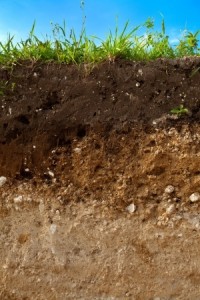Most people have never given any thought to the dirt that they walk on. But soil is a critical component of our landscapes. It’s a complex mixture of weathered minerals, organic matter, microorganisms, water, and soil air. The majority of tree health problems in Hampton Roads are not caused by insects or disease, they are caused by poor soil conditions that strain a tree’s capacity to absorb the necessary water and nutrients. Improve soil conditions and your trees will thrive.
Physical Soil Properties
Sand, silt, and clay make up the mineral content of a soil. The largest particles are sand, the smallest are clay, and silt is intermediate in size. The relative proportion of these particles determine the soil texture. A good loamy soil has about forty percent sand, forty percent silt, and the remaining twenty percent is tiny clay particles. This mixture, or soil texture, influences the chemical and biological soil properties, and has a marked effect on the ability of tree roots to absorb water and nutrients.
Individual soil particles become “glued” together, or aggregated, by complex interactions between the soil microorganisms, soil particles, root growth, and temperature changes that can freeze and thaw the soil. These secondary groupings of soil particles are called aggregates. The amount, size, shape, and electrostatic properties of soil aggregates contribute to soil structure. This resultant mini-architecture of the soil helps determine its water and nutrient holding capacity. A good loamy soil with good soil structure has about fifty percent pore space. This pore space contains the air and water that allow tree roots to respire and obtain water and nutrients.
Between these soil aggregates are various sized pore spaces. The larger pore spaces, referred to as macropores, are generally filled with the air that provide tree roots access to oxygen. The smaller spaces, or micropores, can contain water that is available to tree roots. After receiving rainfall or irrigation, the water that initially fills the macropores quickly drains away. However the water inside the micropores persists long enough for the tree roots to absorb it. There is some water in the soil that is permanently unavailable to tree roots because it is tightly held by soil particles. Because water consists of polar molecules — meaning that they have electric poles, both negative and positive — they can adhere so tightly to electrically charged clay particles that tree roots cannot absorb them.
If good soil structure is destroyed by the weight and pressure of vehicles, foot traffic, or hard rains on bare ground, then we say the soil is compacted. Compacted soils lack good soil porosity. Lack of macropores restricts root growth and limits the water and nutrients available to the roots. Good soil management is mindful of these basic physical soil properties and creates conditions where trees can be vigorous and healthy.

